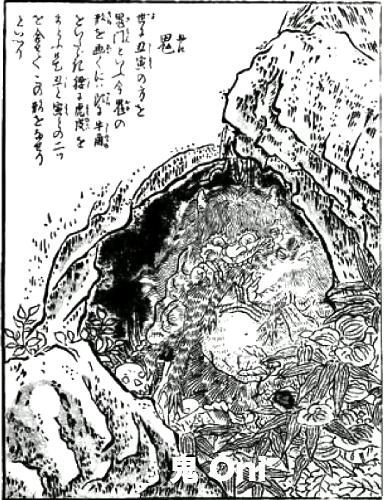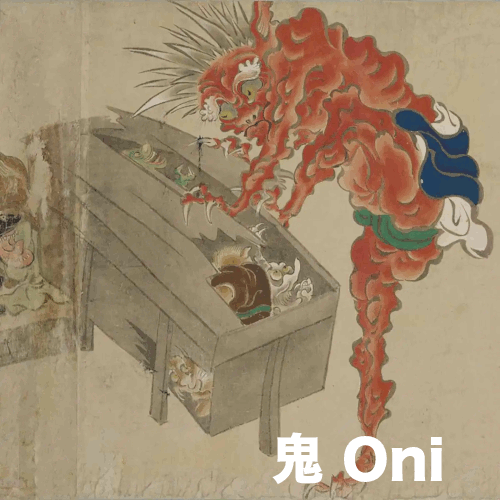Oni are a type of supernatural being in Japanese folklore, often depicted as large, fearsome creatures with horns and sharp claws. They are generally known for causing destruction, bringing misfortune, or punishing wrongdoers. Whether oni are visible or invisible depends largely on the story, context, and cultural perspective.
The popular image of One (demons) as having horns on their heads, wearing tiger-skin loincloths, and possessing great strength while being malevolent towards humans became more standardized during the Edo period (1603-1868). However, before this period, their appearance and roles were more fluid and less fixed.
Where do Oni (demons) come from?
The concept of Oni may have been imported from China. In China, the term 鬼 (guǐ) seems to refer to the souls or spirits of the deceased. It also carried the aspect of being a malevolent or vengeful spirit.
In ancient China, it was believed that souls that were not properly buried would become 鬼 after death. These ghosts were said to affect their families or living people. Additionally, souls of those who were treated unjustly in life or who died harboring resentment became 厄鬼 (disastrous spirits). These spirits were feared as they were believed to cause calamities.
The existence of such spirits later formed the foundation of ancestor worship and rituals for honoring the dead. Rather than being simply terrifying beings, they are closely tied to beliefs about the peace of the deceased’s soul and ancestor veneration, connecting deeply with views on life and death.
Imported Oni from China
This is just speculation, but could it be that the concept of Oni was imported from China through the Kenzuishi (Japanese missions to Tang China) or the Kentohshi (Japanese missions to China)? This is because the kanji character for Oni itself was brought from China.
It’s possible that invisible spirits were believed to exist, and those spirits that had been treated unjustly became Oni, recognized as beings that brought calamity.
Invisible Oni
At the very least, Oni in the Heian period were invisible, supernatural entities. Oni were considered evil beings that caused various disasters such as typhoons, large fires, and illnesses.
The origin of the word “oni” is said to come from the term “onn” or “onu,” meaning “hidden” (隠). The character “隠” refers to a world separated from the real, physical world—a concept pointing to an otherworldly or spiritual realm. With this understanding, the word “oni” originates from this idea of being “hidden,” suggesting that oni are not inhabitants of the visible, real world but rather beings from an invisible, spiritual world.
For the people of the Heian period, it wasn’t so much a question of whether Oni physically existed, but rather it was commonly accepted that Oni did exist. They clearly regarded oni as representations of unseen fears and disasters. It was a matter of fact in their worldview that these supernatural beings were responsible for the misfortunes and calamities they experienced.
Rokujoh no Miyasudokoro
In the Heian period, Oni were sometimes perceived as visible manifestations of negative emotions such as malice, jealousy, and anger that resided within the human heart. Because these emotions were invisible, oni might have been considered entities from the realm of the “hidden” (隠), existing as unseen forces.
A famous example of emotions transforming into an oni-like presence is the story of Rokujoh no Miyasudokoro’s vengeful spirit in The Tale of Genji, regarded as one of the earliest novels. Her intense jealousy manifests as a vengeful spirit that attaches itself to Aoi no Ue and ultimately leads to her death, a tale that continues to be recounted in modern Japan.
In summary, Oni in the Heian period may have essentially referred to supernatural occurrences caused by invisible disasters or negative emotions.
Sugawara no Michizane
Sugawara no Michizane (845-903) was a distinguished scholar and politician who served the imperial court and eventually rose to the rank of Udaijin (Minister of the Right). However, his political career was marred by intense rivalries, especially with the Fujiwara clan, which significantly impacted his later life.
Despite being at the height of his power, Michizane was unjustly demoted and exiled to Dazaifu (in present-day Fukuoka Prefecture). This exile caused him deep emotional distress, and he passed away in 903 in a state of solitude and despair. Following his death, public sympathy for his misfortune grew.

After Michizane’s death, many individuals involved in his exile, including his political adversary Fujiwara no Tokihira, faced mysterious deaths. Additionally, a series of natural disasters and anomalies occurred, including the famous lightning strike at Seiryohden (the Emperor’s residence), which left a strong impression on the people of the time. These events were interpreted as signs of Michizane’s vengeful spirit, leading to his deification as Tenjin, the god of learning and scholarship.
The Lightning of Sugawara no Michizane
The events surrounding Sugawara no Michizane were considered to be caused by his vengeful spirit, leading the court to decide to enshrine him as a deity in order to appease his wrath. He is now worshipped as Tenjin, the god of learning and scholarship.
Sugawara no Michizane, who died with unresolved grievances due to his unjust treatment, is revered as one of Japan’s three major vengeful spirits. His spirit, believed to have caused natural disasters and calamities, embodies aspects of an invisible, supernatural entity—much like the traditional concept of Oni. His vengeful spirit, manifesting as these disasters, reflects the notion of an unseen, powerful force causing turmoil.
Visible Oni
However, Oni are not always completely invisible; there are accounts of them being seen. For example, in the late Heian period collection Konjaku Monogatari-shuh, there is a reference to a being known as 板鬼 (Itaoni). Additionally, 酒呑童子 (Shutendohji) who is said to have lived on Ohe-Yama Mountain, and his subordinate 茨木童子 (Ibaraki-dohji) are both depicted as visible demons in various stories.
板鬼 (Itaoni)
During the Heian period, samurai had a role known as “宿直” (tonoi). The primary responsibilities of tonoi included guarding the imperial palace and the residences of the nobility. This role involved patrolling at night to protect against dangers such as suspicious individuals, fires, and theft, thereby safeguarding both the aristocrats and their property. Given the nature of their duties, it is likely that they frequently encountered supernatural phenomena and strange occurrences during their nighttime vigilance.

When a samurai encountered 板鬼 (Itaoni), it is described as follows:
In the past, it is said that two young samurai were on guard duty in the southern room of a certain house during the summer. These two samurai, who were originally from humble backgrounds, were armed with long katana and were talking while lying down. Meanwhile, a senior samurai, who held a position of rank, was sleeping alone in the upper guard room, without a katana or any other weapon.
As the night grew late, the two samurai noticed a board suddenly protruding from the roof of the eastern platform. They wondered what this might be, thinking, “There shouldn’t be a board sticking out there. Perhaps someone might be trying to start a fire and climb onto the roof. If so, they would normally raise the board from below, not have it stick out from above. This is unusual.”
As they observed, the board slowly extended to about seven or eight feet. The sight was so strange that they thought, “This must be a demon.” They drew their katanas, ready to attack if it came closer. They crouched down, adjusting their grip on their katanas. However, the board did not come closer but instead slid stealthily through a gap in the lattice work nearby.
Seeing this, the samurai realized that the board had entered the area where the sleeping senior samurai was. They found him crushed as if he had been pressed down by something, and he made a few groans but did not make any further sound. The samurai, startled and alarmed, woke others and reported the situation. When people gathered with torches and checked, they found that the senior samurai had been killed. The board was nowhere to be seen either inside or outside. Everyone was terrified by the incident, and the body of the senior samurai was hastily removed.
Reflecting on this, it seems that the presence of the board was likely a sign of the demon, which had come to kill the defenseless senior samurai because the two samurai, who were prepared with katanas, were unable to drive it away. From then on, people believed that carrying katanas was necessary, and this story became a common lesson about the need to be prepared and armed.
Konjaku Monogatari-shū, Volume 27, Story 18, is titled “The Tale of the Oni Who Appeared as a Board and Killed a Man.”
Oni Has Horns
In the Heian period, there were both invisible oni associated with disasters and epidemics and visible onies that were seen as bandits or outlaw groups.
However, if you were to ask people in the Reiwa period about onies, they would likely refer to the visible kind. During the pandemic of the COVID-19, no one claimed, “This is the work of onies.” The advancements in various technologies have likely transformed the invisible onies into visible ones.
Now, when asked about the appearance of onies, most Japanese people would likely respond with a description like the following.
- Having horns.
- Hair is shaggy.
- Wearing a tiger-striped loincloth.
- Holding a golden club.
This is the appearance of a oni in modern times. In terms of immense strength and durability, it might be somewhat similar to figures like Shutendohji or Ibakidoji.
This shared understanding of the appearance of oni, despite not being taught in compulsory education, can be traced back to the Edo period.
During the Edo period, the Image of Oni in Japan was Firmly Established
The images of horns and tiger stripes are related to the concept of 鬼門 (Kimon), which refers to the northeast direction considered to be the point from which malevolent forces or evil spirits might come. This concept originates from Chinese theories of yin-yang and the five elements, which were imported into Japan.

In Japanese culture, the concept of directions is influenced by the Chinese yin-yang and five elements theory, which is reflected in the twelve zodiac signs (十二支). For instance, the direction of “丑寅” (Northeast) is associated with the strongest presence of “yin” energy, making it a direction prone to the entry of malevolent spirits and disasters.
That’s an insightful connection. The association between the northeast direction (hoku-toh), the 丑 (ox), and the 寅 (tiger) with the image of oni wearing horns and tiger-skin garments is a fascinating example of how cultural symbols and beliefs intertwine.
The idea that the northeast is considered an inauspicious direction associated with strong “yin” energy, and hence with the presence of malevolent spirits or disasters, likely contributed to the depiction of oni in this way. The horns represent the ox, and the tiger-skin symbolizes the tiger, reinforcing the image of oni as formidable and fearsome beings.
Summary
The discussion has expanded in various directions, but it seems that the concept of oni originally emerged from a fusion of ideas imported from China and indigenous spirit worship. As a result, oni were initially considered invisible entities. However, as supernatural phenomena and visible disasters like epidemics emerged, oni gradually became depicted as visible entities.
The leader of such notorious oni as Shutendohji also appeared, and there are legends of the demons being defeated, making them visible entities. On the other hand, the head of Shutendohji became an object of worship for curing ailments and injuries related to the head.
The concept of “Kishin” (demon gods), represented by Gozu Tenno, became deeply rooted in Japanese culture. Because kishin are fearsome deities, they are enshrined in shrines with reverence and awe. The festival to appease their anger evolved into one of Japan’s most famous festivals, the Gion Matsuri.
Even the human mind can turn into a demon. While visible demons are fearsome, the invisible demons of malevolent intentions within ourselves can be just as terrifying.



コメント